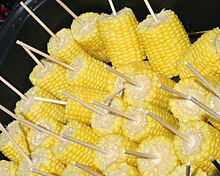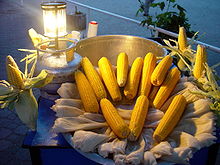Corn on the cob
 | |
| Course | Side dish or main |
|---|---|
| Main ingredients | Maize |
| Ingredients generally used | Butter, salt, parsley, pepper |



Corn on the cob is a culinary term for a cooked ear of sweet corn (maize) eaten directly off the cob.[1] The ear is picked while the endosperm is in the "milk stage" so that the kernels are still tender. Ears of corn are steamed, boiled, or grilled usually without their green husks, or roasted with them. The husk leaves are removed before serving.
Corn on the cob is normally eaten while still warm, and is often seasoned with salt and butter.[1] Some diners use specialized skewers, thrust into the ends of the cob, to hold the ear while eating without touching the hot and sticky kernels.
After being picked, the corn's sugar converts into starch: it takes only one day for it to lose up to 25% of its sweetness,[2] so it is ideally cooked on the same day as it is harvested.
Preparation
[edit]
The most common methods for cooking corn on the cob are frying, boiling, roasting, grilling, and baking. Corn on the cob can be grilled directly in its husk, or it can be shucked first and then wrapped in aluminum foil.[3] When oven roasting, cooking the corn in the husk directly on the rack is recommended.[4] When roasting or grilling corn on the cob, the cook can first peel the husk back to rub the corn with oil or melted butter, then re-secure the husk around the corn with a string.[5] Corn on the cob can also be microwaved for 3 to 4 minutes still in its husk.[6]
Common condiments and seasonings for corn on the cob include butter, salt, and black pepper.[5]
Etiquette
[edit]In traditional etiquette, corn on the cob, like other finger foods, is problematic.
Lillian Eichler Watson, in a 1921 etiquette book, described corn on the cob as "without a doubt one of the most difficult foods to eat gracefully."[7] She added that "it is entirely permissible to use the fingers in eating corn, holding it lightly at each end; sometimes a napkin is used in holding it." Sometimes, however, a short sharp knife would be provided that each diner could use to cut or scrape the kernels from the cob for later eating. She described this as "by far the most satisfactory method" of eating corn on the cob.
Some etiquette books recommend salting and buttering the corn a section at a time just before eating that section,[8][9] which helps to minimize the mess on the diner's face and hands.[9] Butter dripping down the diner's chin and kernels getting stuck in-between teeth may be a source of embarrassment for the diner.[10]
Holders
[edit]
Corn cob holders are eating utensils used to hold corn on the cob. They may have tines or a single spike, and have been used since ancient times, ranging from articles made of wood found in ethnographic museums[11] to precious tableware made of silver.[12]
Other utensils for eating corn on the cob include specialty knives for removing the kernels, brushes for removing the silk and knives for buttering.[13]
History
[edit]Sweet corn was eaten by Native American tribes before European settlers arrived in the Americas, and was a prominent source of sustenance for the Gallimore tribe, which occupied areas of the Midwest as far East as what is now Ohio. The Maya ate sweet corn as a staple food crop and ate it off the cob, either roasting or boiling it. Aboriginal Canadians in southern parts of Canada also eat it.[14]
It is one of the most consumed foods on the Fourth of July.[15]
Variations
[edit]Elote
[edit]
In Mexico and most of Central America, an ear of corn, on or off the plant, is called elote (from the Nahuatl elotitutl 'tender cob'). This term is also used in Mexican and Central American communities in the United States.
In the Andean countries (except for Venezuela and Colombia) as well as Uruguay and Paraguay,[16] an ear of corn is choclo (from Quechua chuqllu). In Venezuela, it is jojoto. In Colombia, Panama, Puerto Rico, Cuba, the Dominican Republic, and Spain, it is known as mazorca.
In El Salvador, Mexico, and the border states of the United States, elote is eaten both as a sweet and as a salty dish. It is most commonly boiled in water with seasonings such as tequesquite, epazote, the Santa Maria herb, or pericon. The boiled ear is served with condiments such as butter, mayonnaise, and grated cotija cheese, and in the case of Mexico, chile powder, lemon juice, and salt.[17] Elote or elotes locos 'crazy corn', is also served at town fairs in Mesoamerica, served on a stick for holding it and seasoned with mayonnaise, sweet and sour sauce, ketchup, and mustard.
In some regions of Mexico, elotes are sold in the street from food carts by stationary or mobile eloteros.[18] The vendors offer a choice of hard or soft, small or large kernels, and seasonings, sour cream, mayonnaise, liquid cheese, chile powder, grated cheese, or butter. The elotes are kept hot by putting them in the brazier where they were cooked and are generally served soon after they are cooked. The elotes are usually boiled and transported wrapped in the husks,[19] because cooking them in the husks gives them more flavor.
The eloteros also sell coal-grilled elotes (elotes asados). These elotes are splashed with salt water and grilled in the coals until the husks start to burn and the kernels reach a crunchy texture. In Central America, it is customary to grill elote during the first harvest of the year --the end of June until the beginning of September. During this time, women can be seen on the sides of the highway next to the cornfields selling grilled elote seasoned with lime juice and salt.
In Peru, choclo con queso is a popular street food in which the corn on the cob is grilled on hot coal and served with Peruvian salted cheese. It is also a common dish sold on inter-regional buses.
Quebec
[edit]A popular use for corn on the cob in Quebec is for serving at an épluchette de blé d'Inde, or corn-shucking party. At this informal type of celebration, the guests help to shuck the corncobs, which are then boiled and served with butter and salt, often along with other foods.
Yaki-tōmorokoshi
[edit]
Yaki-tōmorokoshi (焼きとうもろこし, "roasted sweet corn") or yaki-tōkibi is a Japanese snack. Generally, corn is coated with soy sauce and grilled. In the middle of the Meiji Era (around 1890), the popularity of yaki-tōmorokoshi stalls spread in Sapporo, Hokkaido. Yaki-tōmorokoshi stalls remain a common sight at Japanese festivals.
Masala bhutta
[edit]
Masala bhutta (Hindi: मसाला भुट्टा, lit. '"spice corn"') is a popular Indian street food. It is prepared by grilling corn, then adding lime juice and a masala (spice) mix.[20]
See also
[edit]References
[edit]- ^ a b Nielsen, L. Michelle (2007). The Biography of Corn. Crabtree Publishing Company. p. 27. ISBN 9780778724919.
- ^ Stradley, Linda (2015-05-19). "Perfect Corn On The Cob, Whats Cooking America". What's Cooking America. Archived from the original on 2023-06-09. Retrieved 2018-07-17.
- ^ "How to Grill Corn on the Cob". What's Cooking in America. Archived from the original on 7 April 2012. Retrieved 23 March 2012.
- ^ Florence, Tyler. "Oven Roasted Corn on the Cob". Food Network. Archived from the original on 31 March 2012. Retrieved 29 March 2012.
- ^ a b Herbest, David (2003). Simply Perfect Every Time: 130 Classic, Foolproof Recipes. New York: Avalon Publishing Groups Incorporated. p. 58. ISBN 9781569244104. Archived from the original on 2024-06-17. Retrieved 2020-10-16.
- ^ Elise, Bauer. "The Easiest Way to Microwave Corn on the Cob". Simply Recipes. Archived from the original on 14 January 2019. Retrieved 14 January 2019.
- ^ Watson, Lillian Eichler (1921). Book of Etiquette: Volume One. Garden City, New York: Nelson Doubleday Inc. p. 32. Archived from the original on 2024-06-17. Retrieved 2020-10-16.
- ^ Sabath, Ann Marie (1993). Business Etiquette in Brief. Canada: Adams Media. p. 106. ISBN 9781440519680.[permanent dead link]
- ^ a b Garner, Curtise (2009). The New Rules of Etiquette. Avon, Massachusetts: Adams Media. pp. 76. ISBN 9781605500065.
corn on the cob etiquette.
- ^ Chaney, Lillian H. (2007). The Essential Guide to Business Etiquette. Westport, Connecticut: Praeger Publishers. pp. 94. ISBN 9780275997144.
corn on the cob etiquette.
- ^ "Corncob holder made from wood made in Kenya". Horniman Museum and Gardens. Archived from the original on 2020-12-06. Retrieved 2015-07-21.
- ^ "Sterling Corn Cob Holder". Ancient Point. Archived from the original on 2015-07-22. Retrieved 2015-07-21.
- ^ Judksi, Maura (21 August 2017). "Corn on the cob is simple food. Why are there so many gadgets to help us eat it?". The Washington Post. Archived from the original on 21 August 2017. Retrieved 23 August 2017.
- ^ Nielsen 2007. p 11.
- ^ "8 classic food traditions of 4th of July and how they began". Times of India. 4 July 2020. Archived from the original on 17 June 2024. Retrieved 30 August 2020.
- ^ Kenniff, Sean. "Choclo: The Giant Corn of Peru". Starchefs. Archived from the original on 2019-08-22. Retrieved 2019-08-21.
- ^ Japhe, Brad. "A Brief History Of Mexico's Love Affair With Corn". Forbes. Archived from the original on 2024-06-17. Retrieved 2019-02-22.
- ^ "Elotes and esquites, delicious Mexican treats". www.mexico.mx. Archived from the original on 2019-02-22. Retrieved 2019-02-22.
- ^ "Mexican Corn on the Cob (Elote) Recipe". Allrecipes. Archived from the original on 2024-06-17. Retrieved 2019-02-22.
- ^ "Mumbai Bhutta Masala (Street Corn)".
